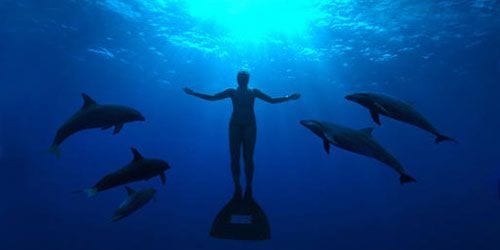
Dolphin trainer Ric O’Berry became famous as the direct support for Flipper, the beloved star of the movie and TV series in the ’60s. Now just shy of 70-years-old, the hardened expert has become renowned as an activist who fights against the mistreatment of dolphins. His primary target is Japanese fishermen, who murder and capture the treasured mammals for profit.
Claiming they are following the legacy of their ancestors, the small-town guys are supporting big business. Along with selling dolphin and whale meat in grocery stores, they also ensnare them for display around the world. While this practice is condemned by governments, none are taking efforts to stop these killings. This lackadaisical approach to the matter drives a small group of individuals to take matters into their own hands.
The Cove depicts the efforts of brave activists willing to risk arrest on foreign soil to present the truth. First-time director Louis Psihoyos is directly involved in this pursuit, and is the co-founder of the Oceanic Preservation Society (OPS). Formed in 2005, this entity is focused on marine conservation and environmental rights around the world. OPS is directly involved in this film, which clearly sets out to inspire audiences to get involved in saving the dolphins. Psihoyos appears on screen and does a lot more than simply document their activities. This adds a personal stake in the story and avoids delivering a talking-head lecture. We’re on the ground with the participants and experience the events firsthand.
This film takes place mostly in Taijii, Japan, which is a central hub for the brutal killing of dolphins. Psihoyos and writer Mark Monroe (The Tillman Story) do an excellent job giving interesting background that sets the stage for the later events. O’Berry is a fascinating man, evolving from a rich and famous TV star to a much different role. He candidly discusses the key moments that changed his perspective and led to this fervent cause. Because he’s spoken out against the Japanese fishermen, he travels around Taijii in disguise and is frequently hassled by police. He seems like a paranoid guy in the early scenes, but it’s clear he’s not overstating the authorities’ focus on his every move.
The small town of Taijii is a remarkable study in contradictions. There are numerous locations that appear to express the townspeople’s love of whales and dolphins. One example is the notorious Taijii Whale Museum, which contains exhibits on whales and whaling and might appear to offer a positive feeling about whales. However, this location is also the central hub for the vicious killings taking place nearby. The town even has several yearly festivals that are themed on whales, which makes the whaling activities and dolphin killings even more distressing.
Psihoyos and his crew invade the cove like James Bond sneaking into the highly guarded lair of an over-the-top villain. They use thermal imaging goggles and special camera equipment during the night to avoid the local police. One striking piece of equipment is the rock cam, which was developed with the major visual effects company Industrial Light & Magic. Placed within the landscape, the camera sits unnoticed and provides up-close footage of the slaughter.
The Cove closes with an extended sequence that offers a horrifying look at the slaughter of a large group of dolphins. The fishermen wield complex harpoons that quickly decimate the mammals all around them. The once-attractive waters of the cove become an ugly pool of blood-red liquid. It’s hard to imagine that anyone can view this scene and not feel anger that this practice continues in modern society. Without overplaying the effect, Psihoyos lets the stunning footage sink into our consciousness. I promise this is not an image you’ll easily forget, but it’s a must-see for anyone who cares about our environment.
This Blu-Ray edition includes a nice collection of bonus features that complement the movie. The main extra is a commentary from Psillhoyos and Producer Fisher Stevens, who provide excellent details about the events that passed us by quickly in the film. It’s a fairly dry discussion, but the conversation will be intriguing if you’re interested in the subject matter. There are also three deleted scenes, covering about nine-minutes, which include more engaging material. The highlight is a closer look at the surfers’ Paddle Out ceremony in the cove led by Dave Rastovich in 2007. This group included actresses Hayden Panettiere and Isobel Lucas and faced some nastiness from local fishermen.
“The Cove: Mercury Rising” is an 18-minute featurette that looks at mercury poisoning and how eating “safe” fish like tuna can actually has a nasty effect on mercury levels. Psihoyos had the highest level of mercury his doctor had ever seen. This feature is an interesting depiction of the rising problem of mercury poisoning in the world’s waters. Finally, there are brief looks at the unique equipment used and beautiful underwater footage with dolphins and other marine life.
I consider myself a concerned environmental citizen, so I’m certainly an easy sell for the feelings presented by The Cove. Looking at the film and not its message, I still feel that it also works as an effective documentary. Along with the activism and interviews, this film includes gorgeous underwater footage that shines in the Blu-Ray format. It attacks the slaughtering of the dolphins while reminding us just how impressive they can be.
